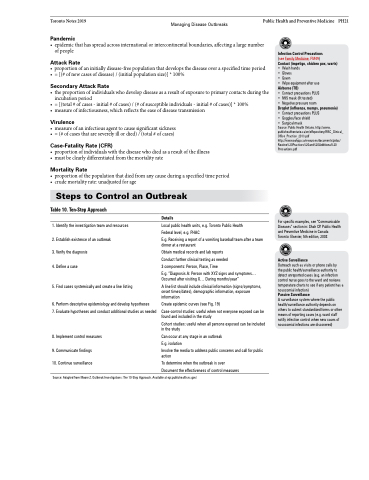Page 1239 - TNFlipTest
P. 1239
Toronto Notes 2019 Managing Disease Outbreaks Public Health and Preventive Medicine PH21
Pandemic
• epidemicthathasspreadacrossinternationalorintercontinentalboundaries,affectingalargenumber of people
Attack Rate
• proportion of an initially disease-free population that develops the disease over a specified time period • =[(#ofnewcasesofdisease)/(initialpopulationsize)]*100%
Secondary Attack Rate
• theproportionofindividualswhodevelopdiseaseasaresultofexposuretoprimarycontactsduringthe incubation period
• =[(total#ofcases-initial#ofcases)/(#ofsusceptibleindividuals-initial#ofcases)]*100%
• measureofinfectiousness,whichreflectstheeaseofdiseasetransmission
Virulence
• measureofaninfectiousagenttocausesignificantsickness • =(#ofcasesthatareseverelyillordied)/(total#ofcases)
Case-Fatality Rate (CFR)
• proportionofindividualswiththediseasewhodiedasaresultoftheillness • mustbeclearlydifferentiatedfromthemortalityrate
Mortality Rate
• proportionofthepopulationthatdiedfromanycauseduringaspecifiedtimeperiod • crudemortalityrate:unadjustedforage
Steps to Control an Outbreak
Infection Control Precautions
(see Family Medicine, FM49)
Contact (impetigo, chicken pox, warts)
• Wash hands
• Gloves
• Gown
• Wipe equipment after use
Airborne (TB)
• Contact precautions PLUS
• N95 mask (fit tested)
• Negative pressure room
Droplet (influenza, mumps, pneumonia)
• Contact precautions PLUS
• Goggles/face shield
• Surgical mask
Source: Public Health Ontario. http://www. publichealthontario.ca/en/eRepository/IPAC_Clinical_ Office_Practice_2013.pdf http://www.oahpp.ca/resources/documents/pidac/ Routine%20Practices%20and%20Additional%20 Precautions.pdf
For specific examples, see “Communicable Diseases” section in: Shah CP. Public Health and Preventive Medicine in Canada Toronto: Elsevier, 5th edition, 2003
Active Surveillance
Outreach such as visits or phone calls by
the public health/surveillance authority to detect unreported cases (e.g. an infection control nurse goes to the ward and reviews temperature charts to see if any patient has a nosocomial infection)
Passive Surveillance
A surveillance system where the public health/surveillance authority depends on others to submit standardized forms or other means of reporting cases (e.g. ward staff notify infection control when new cases of nosocomial infections are discovered)
Table 10. Ten-Step Approach
1. Identify the investigation team and resources
2. Establish existence of an outbreak 3. Verify the diagnosis
4. Define a case
5. Find cases systemically and create a line listing
6. Perform descriptive epidemiology and develop hypotheses
7. Evaluate hypotheses and conduct additional studies as needed
8. Implement control measures
9. Communicate findings 10. Continue surveillance
Details
Local public health units, e.g. Toronto Public Health Federal level, e.g. PHAC
E.g. Receiving a report of a vomiting baseball team after a team dinner at a restaurant
Obtain medical records and lab reports
Conduct further clinical testing as needed
3 components: Person, Place, Time
E.g. “Diagnosis A: Person with XYZ signs and symptoms... Occurred after visiting X... During months/year”
A line list should include clinical information (signs/symptoms, onset times/dates), demographic information, exposure information
Create epidemic curves (see Fig. 19)
Case-control studies: useful when not everyone exposed can be found and included in the study
Cohort studies: useful when all persons exposed can be included in the study
Can occur at any stage in an outbreak E.g. isolation
Involve the media to address public concerns and call for public action
To determine when the outbreak is over Document the effectiveness of control measures
Source: Adapted from Moore Z. Outbreak Investigations: The 10-Step Approach. Available at epi.publichealth.nc.gov/


